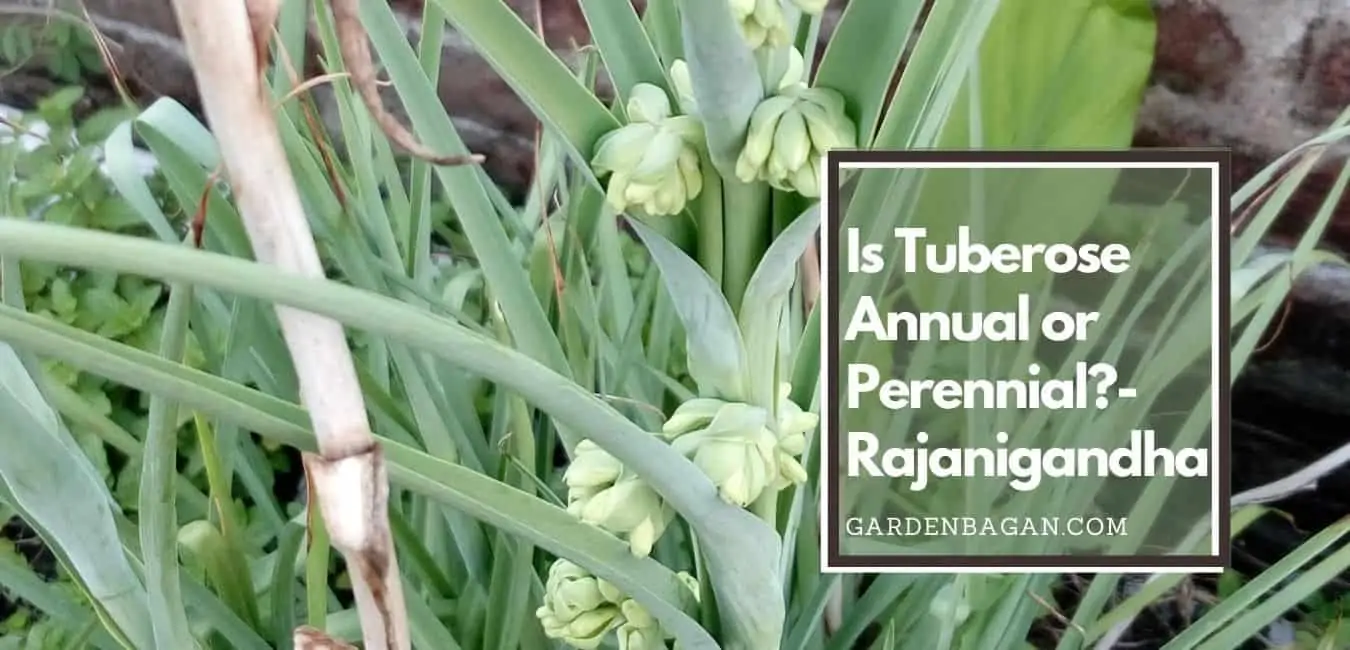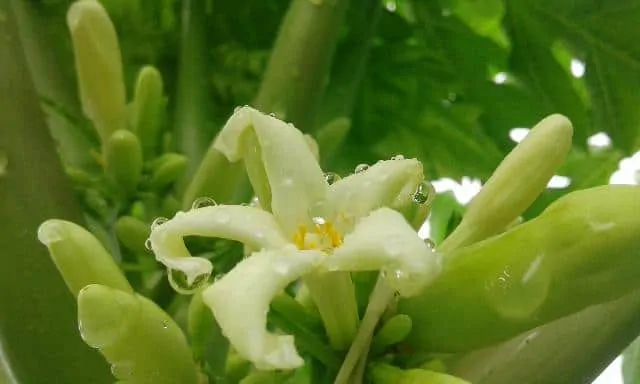Is Tuberose annual or perennial?– Tuberose is a Perennial fragrant flowering plant. It belongs to the Asparagus Family- ‘Asparagaceae‘. It is a tropical plant native to Mexico. Tuberose is a hardy perennial plant in USDA zone 9-11. Texas and Florida especially gulf area is the major cultivator of Tuberose in the United States.
Tuberose is cultivated for its fragrant flowers and essential oil. Tuberose is a summer cultivar still it is perennial to the native climate. It is an annual flowering plant only in cold USDA zone 6-8.

The Scientific Name of Tuberose is- Agave Amica, It was formally known as -Polianthes tuberosa
Check out my previous post: How to Grow Tuberose- Polianthes Tuberosa, Rajanigandha?
How long does tuberose last?
10 to 15 days of germination followed by 8-120 days of maturing and finally 60-90 days of the summer season. Overall a tuberose plant can last a minimum of 240 days or 8-9 months.
In a warm Tropical climate, a Tuberose can survive winter with minor leaf loss. If you experience an average temperature above 4-degree Celcius or 40- Fahrenheit during winter. Then most probably your tuberose plant will stand the cold.
You may find some yellow dry leaves but it’s ok. The plant will be fine. It can even survive 0-degree Celcius or 32 Fahrenheit for 7 days.
In Ideal climatic conditions, If the average day temperature stays above 75-80-Fahrenheit. Then a Tuberose plant can last up to 9 months. It will keep growing in the flowering season, spring to late Summer. In a non-frigid zone, the plant can survive the winter.
Is tuberose seasonal?
Tuberose is commercially a seasonal cultivar. It is true that we have classified tuberose as a perennial plant. Still, we grow tuberose in summer. The Plant develops a flower spike after 4 months of germination, probably in the mid-summer.
Each bulb produces only one flower spike every season. The plant is of no use once the flowers are harvested. You have to wait for the next flowering season for another cultivar. Therefore Tuberose is a perennial yet seasonal flowering plant.

How much cold can Tuberose survive?
Tuberose can not survive in the soil at a temperature below -6.7 degrees Celcius or 20 Fahrenheit. Open bulbs must be kept at a temperature above 10 degrees Celcius or 33.8 Fahrenheit.
The bulb can fridge or easily get damaged at a temperature below this range. Therefore, use heavy mulch before fall to protect the bulbs in the ground. Organic mulch can prevent temperature loss and decompose slowly to feed the bulb in spring.
Why is my Butterfly Pea plant not flowering?-Clitoria Ternatea
Will Tuberose die in Winter?
Yes Tuberose can die in winter. Especially if the plant is not healthy or the bulb is above the soil surface. Open bulbs can shrink due to fridging cells. Eventually, it may die. Generally, 20% of new baby tuberose bulbs die every year during the cold winter season.
It is true that a tuberose plant can die in winter but this is not very hard to handle. Generally we gardeners use many techniques to prevent frostbite in our plants. Also, this situation is only common in cold regions, especially USDA Zone 6 and 7.
Tuberose plants can survive outside temperature in USDA zone 8-11. As professionals, we generally dig out the tuberose bulbs after the first frost. It is convenient and efficient to save healthy and mature bulbs for the next season. It will give you some extra garden space for winter gardening.
Yes, I know it is a very time and labor-intensive job. If you don’t want to dig some soil or do this stuff then don’t worry. You can use some organic mulch like fine wood chips or sawdust or peat moss to cover the bulbs. It will keep the bulb warm and safe from the upcoming winter.
Does Tuberose grow back again in the Spring?
Yes, Tuberose bulbs can grow back in spring. Proper temperature and a healthy bulb are the only requirements. If you have left the bulb in the ground and if it’s safe. Then you will see new growth in the early spring.
The Tuberose bulbs will start sprouting once the temperature exceeds 60 Fahrenheit. Although not all of them will grow. It is a fact that some of the bulbs may have died and will never grow again. Don’t worry, it is a natural phenomenon. The survivors will grow and multiply to fill the empty space in no time.
Don’t forget to feed these new plants. Tuberose is a heavy feeder and required a boot to recover from winter hibernation. Apply NPK 8:8:8 in the early spring to boost tuberose plant growth.
What do you do with tuberose in the winter?
You can simply leave the bulbs in the soil if you live in USDA zone 8 and above. If the average winter temperature doesn’t fall below -5 degrees Celcius or 20 Fahrenheit. Then cover the tuberose blub and plants with 2-3 inch fine organic mulch or compost. There is no need to do anything else. The compost or mulch will take care of the bulbs throughout the fall.
If this is not the condition or You live in a cold zone-6 or 7. Then you should dig the bulbs out of the soil before frost.
- Carefully Take the bulbs out. It should be in clumps. Each clump is a group of one or two big-size bulbs surrounded by 12-15 baby bulbs.
- Clean The bulbs and remove any damaged ones.
- Treat the bulbs with a contact fungicide. Dip the clean dirt-free bulbs in a water solution of any contact fungicide for 20 minutes.
- Then hang the bulbs in shade for 24-48 hours to dry. Follow by drying the bulbs in full sun for 24 hours.
- Next store the bulbs in a well-ventilated cold and dry location.
- You can also Store the clean bulbs in paper bags or cartons with dry mulch and some fungicide.
- Don’t forget to make some holes in the bag or box for proper aeration.
- There is no need for watering or misting these bulbs before sowing in the next spring.
Should we grow tuberose as Annuals or Perennials?
It depends. Yes, It completely depends on your choice, whether you wanna grow tuberose as a perennial or annual. You should consider the local climate and your comfort before deciding.
Make sure your locality has an average winter temperature greater than -5 degrees Celcius. Next, decide whether you want to keep the garden space engaged for the whole winter.
If the temperature is right and you have no problem with the bulbs occupying the garden, container space. Then You can grow tuberose plant as a Perennial.
Otherwise, Growing Tuberose as an Annual flowering plant is the best option. You can harvest the flowers and store the bulbs for the next season.
What do you think- Is Tuberose Annual or Perennial? Let us know your thoughts and ideas.
Keep reading Keep gardening!

